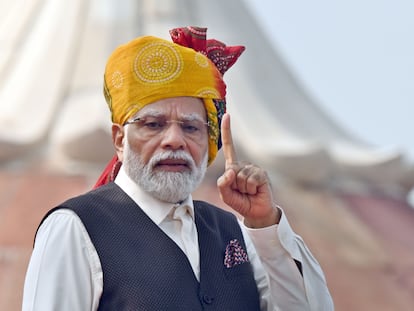How India is seeking to gain ground on China
The South Asian giant is striving to capitalize on its geopolitical position and huge domestic market to establish itself as a manufacturing heavyweight. The city of Bangalore exemplifies its potential and its remaining challenges
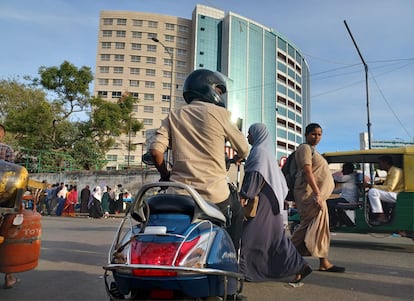
At first glance, the scene is just one of countless images of India’s contrasts. A child walks naked down a dusty street near a group of huts with corrugated iron roofs, a family sits there in a way that doesn’t look like enjoying the free time, but rather wasting time that could be used differently, while modern high-rise towers of more than 20 floors stand in the background. Yet, the situation in this territory transcends the local issue of inequality — a struggle with a global implication is underway here.
Shantytowns and high-rise blocks tower above in the area between the airport and the center of Bangalore. The city is the most booming technological center of a country that is struggling to take full advantage of the West’s eagerness to reduce its dependence on Chinese manufacturing by pushing for new production hubs in other countries and new supply chains. In this area, there are already numerous business ans industrial zones, while others are in development. Truckloads of laborers and tools to build infrastructure churn up clouds of dust, and the sprawling city spill buries dozens of the area’s hundreds of natural lakes. Here, the Indian state government of Karnataka is working to ensure that the Taiwanese company Foxconn builds a new plant to assemble the latest generation of iPhones.

Historically, the vast majority of Apple products have been manufactured in China by Foxconn and selected other contractors. But the U.S. company is now accelerating a progressive diversification process that responds to the need to protect itself from the risks associated with geopolitical tensions between Washington and Beijing, among other things. Foxconn already operates plants in India, but they are small in comparison to its operations in China. Until recently, it only assembled outdated or marginal products in the South Asian powerhouse, but now it wishes to manufacture advanced items as well.
If completed, the Bangalore plant would have a symbolic global value at a time when many countries are jockeying for position, with Vietnam emerging as one of the strongest, in what is a competition on a global scale. In this race, India boasts a geopolitical asset, as it is such a powerful country that Westerners would like to have on their side as a counterbalance to the rise of China. The current reluctance of many democratic leaders to express clear support for Canada after Prime Minister Justin Trudeau denounced serious indications of the Indian government’s involvement in the murder of a Sikh leader on its territory highlights the importance that many attach to maintaining a healthy relationship with New Delhi.
Priyank Kharge, minister of information technology of the government of Karnataka, the state of which Bangalore is the capital, told this newspaper in an interview that “the deal is done” and that the land has already been allocated, though he avoided giving specific details. “They will come,” he insists, referring to Foxconn, a strategic manufacturing juggernaut. Nevertheless, the company maintains discretion on the matter — consulted twice, it did not respond.
Bangalore, a megalopolis with an estimated population of 12 million, is an environment that showcases both India’s global potential and its remaining challenges, ranging from poor infrastructure to internal political tensions. In Karnataka, the party of the Prime Minister, Hindu nationalist Narendra Modi, experienced a heavy defeat in May, and the national level opposition Congress Party is now governing.
From ‘call center’ to worldwide player
The city has evolved from the “world’s call center,” as some say, to a thriving hub for the information technology industry and other sectors, such as the spatial one. The successful mission that landed a robotic vehicle on the hostile south pole of the moon in August was coordinated from this location. In addition to its intrinsic value, this exploit demonstrated the country’s technological capabilities in the eyes of global public opinion.
India possesses great assets to attract investment and catch up with China. “It has a distinct demographic edge with its huge and inexpensive young talent pool of both skilled and unskilled workers, many of whom speak English,” says Samir Saran, president of the Observer Research Foundation (ORF), a think tank believed to be the most influential in the country according to a University of Pennsylvania evaluation.
29-year-old Mohammed Muzammil is one of them. His personal story is symbolic of the collective narrative. He speaks good English, and years ago he worked in one of those call centers that, in the words of Minister Kharge, turned Bangalore into the “back office of the world.” In 2016, with the help of a friend, he started learning how to use SAP software. He then found a job with this specialization, first with Schneider Electric, then Deloitte. Although he has now been out of work for three or four months, he feels completely at ease. He and his wife are expecting a baby — adding to India’s mighty population boom — and as a result, Mohammed is looking for something that will allow him to work remotely. He says this is the only reason why he has not yet found a job, as for someone like him, there is plenty of work.
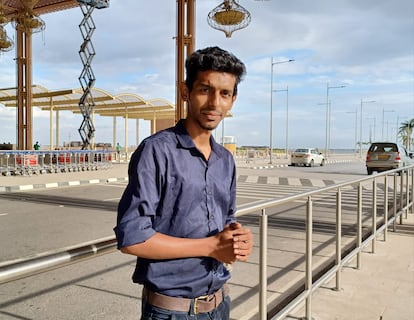
Geopolitics and the workforce are not the only assets in the major global manufacturing upswing. “A growing middle class will soon transform India into the third-largest domestic consumer market,” explains Saran. Establishing production here initially is a way to compete in a growing domestic market, which is also characterized by protectionist measures to promote domestic industry. The “Make in India” initiative promoted by the Modi government incentivizes domestic production while discouraging importation.
India has improved the ease of doing business — it has climbed from 142nd in 2015 to 63rd in 2020 according to the World Bank’s index in this area — its GDP is growing at the fastest pace among the leading economies (6% expected this year). “It is integrating further into the global economy through bilateral free trade agreements given the state of multilateral trade. Companies (and countries) do not want all their eggs in the China basket anymore. They want to create “safer” interdependencies where the threat of weaponisation and disruption is minimal, through what is being called “friend shoring”. India’s “likemindedness” and close relations with most countries, along with improved operating conditions, make it a neat fit” Saran points out.
“India has missed the industrial revolution, it has missed the agricultural revolution, but I think we are in the right place at the right time for the spatial revolution, to lead it,” says Shaju Stephen, president and CEO of Aadyah, a space sector company established in 2016 that serves global clients. Next to him, a room with about thirty young engineers, all under the age of 40, a third of them women, showcases India’s assets (in total, the company has 85 employees, 30 of them women). Its space sector is a testament to this.
“If anyone wants to reduce risks in dependence on China, in Bangalore, the state of Karnataka, we are your first choice. We lead India’s innovation index, we have a plethora of skilled white-collar and blue-collar workers, we are agile,” says Kharge.
Unpaved road
However, the road to becoming a fully developed country and a manufacturing center capable of being a serious alternative to China, if not a competitor, is far from paved.
Alicia García-Herrero, chief Asia-Pacific economist at Natixis, foresees political and socio-economic problems that pose a threat to the country’s upward trajectory. “India certainly has the potential, it has the tailwinds. But I see risks. I fear that there could be turbulence, conflict in India in the future,” she says. “I am concerned that the current leadership of the country does not properly embrace all the different Indians out there. I think that this and an uneven distribution of the prosperity that is being generated may lead to unrest and conflict. Although it may seem that Modi has it all won, I don’t think so. The degree of resentment is huge, even within Hinduism, in its most leftist and intellectual sectors. There are therefore two potentially explosive problems, which go hand in hand, because the biggest inequality is indeed in the Muslim communities,” García-Herrero believes.
“India is probably the most diverse country in the world. Two things unite us: being Indian and the Constitution. If these things are separated, things become complicated. When those in power are not very inclined to abide by the Constitution, then the situation becomes unnerving,” says Kharge, from the opposition — on a national level — Congress Party. “Economic inequality is widespread, but here in the last decade it has expanded,” continues the minister. “The current government is unable to close the gap. Many probably attribute this to nepotism, or too many pro-rich policies. That is cause for concern. Inequality brings social unrest.”
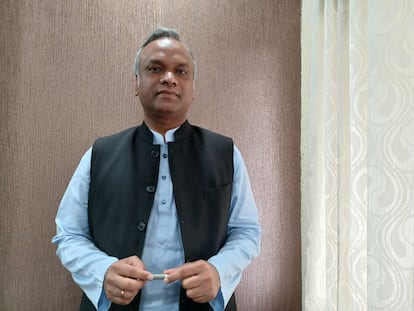
There are further challenges, like infrastructure. From Bangalore, India has admirably and smoothly reached the Moon, but getting from the city center to the Aadyah headquarters in the northeast of the city on any given September morning can involve a 70-minute ride in a cab with no straight roads for more than 100 meters, no public transportation in sight, and a strong stomach and sheer patience. In the summer of 2022, the city experienced severe flooding, partly due to inadequate urban development.
Bangalore is a symbol of India’s tumultuous growth. Ashish Verma, professor of Transportation Systems Engineering at the Indian Institute of Science, explains that the city has no urban master plan and that, despite being similar in size and population to London or Paris, it only has about 60 km of operational subway — compared to 400 km and more than 200 km, respectively. Needless to say, construction work is underway to make improvements. The national government is also striving to promote new infrastructures. But the situation remains very problematic, and the road ahead is challenging.
Infrastructure problems
“There are works to expand the subway network here, but they are progressing slowly. The government is prioritizing roads. There are different reasons for this,” explains the professor. “On the one hand, to satisfy the aspirational side of growth, the economy is expanding, people aspire to own cars, and construction work is being done to make it easier for them to move around. This is complicated, because today India has some 20/25 cars owned per 1,000 inhabitants, and we know from the experience of other economies that when you go from our income levels, about $2,600 per capita, to developed country levels, car ownership shoots up to 600/800 per 1,000. On the other hand, the priority given to highways also has to do with corruption. Their management is more immediate and local with respect to subway lines.”
Verma stresses that, at the national level, a significant effort has been made to modernize the trains. But he points out that, if the proportion of freight and passenger transport was 80% by rail and 20% by road at the time of independence, now it is the other way around. He also says that the expansion of the high-speed rail system is way behind schedule.
This is a key issue. Adequate infrastructure and transportation, from ports and airports to subway lines and railroads, are needed to reach global manufacturing prominence. The new terminal at Bangalore airport is a symbol of the push for improvement and is one of the reasons why a company like Foxconn is considering locating nearby.
Accusations against Adani group
The challenges facing India are not only political and infrastructural. The Adani case is a perfect example. Gautam Adani is the chairman of a large business conglomerate that has recently been accused of gross market manipulation and fraud. Although the group denies the allegations, they have had ample credibility to knock tens of billions of dollars off the group’s stock market value. Adani is a close associate of Prime Minister Modi. The issue at stake in the inquiries is confidence in the integrity of the Indian market and its regulatory bodies.
Another challenge, Stephen points out, is the raw materials issue. “In my opinion, this is a bigger challenge than infrastructure.” For years, China has developed a network for accessing, extracting and refining strategic raw materials, and India is heavily dependent in this sector.
The macroeconomic picture is also somewhat mixed. Along with GDP growth, and after managing to lift hundreds of millions out of poverty in recent decades, there are also signs that exports are advancing. In the smartphone sector, in the 2021 fiscal year they amounted to about $5 billion. In 2022, to more than $11 billion, according to data compiled by S&P.
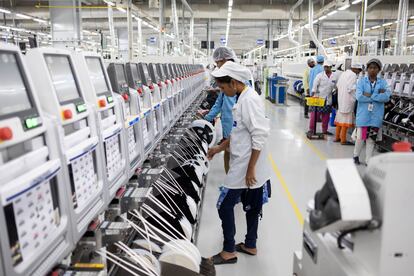
Overall, according to the consulting firm BAIN, manufacturing exports totaled $418 billion in 2022, representing an annual growth rate of 15%. In that year, China exported goods worth more than $3 trillion. However, foreign direct investment, which peaked in the 2021/22 fiscal year at about $83 billion, dropped the following year to approximately $71 billion. Though GDP is growing steadily and in a few years the country will be the third-largest economy on the planet, GDP per capita is still $2,600. This compares with Indonesia’s $5,000, China’s $13,700 and Spain’s $31,200.
Based on these assets and liabilities, India is competing in the great global manufacturing contest. Its future will impact the balances of the new world order. The wastelands around Bangalore will reveal how the outcome will play out. In any case, Mohammed Muzammil and those like him seem confident of a better future.
Sign up for our weekly newsletter to get more English-language news coverage from EL PAÍS USA Edition
Tu suscripción se está usando en otro dispositivo
¿Quieres añadir otro usuario a tu suscripción?
Si continúas leyendo en este dispositivo, no se podrá leer en el otro.
FlechaTu suscripción se está usando en otro dispositivo y solo puedes acceder a EL PAÍS desde un dispositivo a la vez.
Si quieres compartir tu cuenta, cambia tu suscripción a la modalidad Premium, así podrás añadir otro usuario. Cada uno accederá con su propia cuenta de email, lo que os permitirá personalizar vuestra experiencia en EL PAÍS.
¿Tienes una suscripción de empresa? Accede aquí para contratar más cuentas.
En el caso de no saber quién está usando tu cuenta, te recomendamos cambiar tu contraseña aquí.
Si decides continuar compartiendo tu cuenta, este mensaje se mostrará en tu dispositivo y en el de la otra persona que está usando tu cuenta de forma indefinida, afectando a tu experiencia de lectura. Puedes consultar aquí los términos y condiciones de la suscripción digital.
More information
Archived In
Últimas noticias
Most viewed
- Reinhard Genzel, Nobel laureate in physics: ‘One-minute videos will never give you the truth’
- Oona Chaplin: ‘I told James Cameron that I was living in a treehouse and starting a permaculture project with a friend’
- Pablo Escobar’s hippos: A serious environmental problem, 40 years on
- Why we lost the habit of sleeping in two segments and how that changed our sense of time
- Chevy Chase, the beloved comedian who was a monster off camera: ‘Not everyone hated him, just the people who’ve worked with him’

